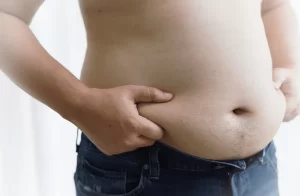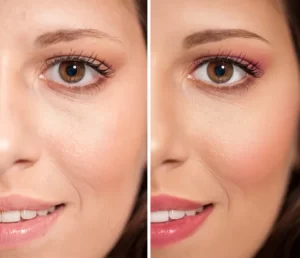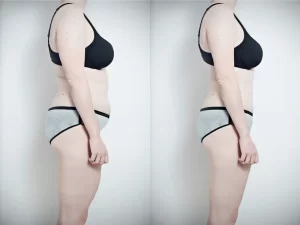A flat tummy is a goal for many. Achieving this can be challenging without the right diet and lifestyle discipline, but there are compelling reasons to lose that extra belly fat.
Losing extra belly fat can lower the risk of chronic health issues, leading the way for a healthier lifestyle. While an overall lifestyle and dietary routine change is the key to losing belly fat, natural ways and medical procedures can also help you.
Understanding Belly Fat and Its Growth
Belly fat, also called visceral fat, and usually builds up around the organs in your tummy area. It’s different from the fat you can pinch on your skin because it sits deeper inside, around important parts of your body like the liver and guts. The location of this fat makes it even more threatening.
Belly fat grows over time due to a combination of factors, including poor diet, lack of exercise, genetics, hormonal changes, stress, etc. Consuming excess calories, mainly from sugary and processed foods, can also lead to belly fat.
Best Ways to Tackle Belly Fat: Natural and Medical Solutions
You can lose belly fat through natural methods involving lifestyle changes or undergo medical interventions when necessary. Some of the best ways are:
- Dietary Changes
A balanced diet rich in whole foods, fibers, protein, and healthy fats can help reduce belly fat. High protein intake can increase the release of peptides, decrease appetite, and promote fullness. Protein also raises your metabolic rate and helps you to maintain muscle mass during fat loss.
Research shows that curbing carbs, especially refined carbs, instead of cutting fat from your diet can lead to better fat-loss results. Limiting the intake of processed foods, sugary snacks, and beverages can reduce the intake of trans fat and aid in belly fat loss.
- Regular Exercise
Regular exercise, which blends weight lifting with cardiovascular activities, effectively targets belly fat.
Weight lifting stimulates muscle growth and increases basal metabolic rate (BMR). As a result, you burn more calories when resting. This process reduces overall fat, including visceral fat around the belly. Additionally, weight lifting promotes muscle development in the abdominal area and helps you get a more defined midsection.
On the other hand, cardiovascular exercises, such as running, cycling, or swimming, are effective for burning calories and reducing body fat percentage. While spot reduction isn’t possible, consistent cardio can help you lose overall fat in the body, including the belly area.
- Lifestyle Change
Implementing lifestyle changes can significantly help to lose belly fat and improve overall health.
Firstly, cutting back on alcohol is essential, as alcoholic drinks are laden with empty calories that contribute to belly fat accumulation. You can surround yourself with health-focused friends to reduce alcohol consumption and get motivated to follow dietary and exercise plans.
Managing stress is essential for losing belly fat, as it triggers the production of cortisol, the stress hormone. This hormone can increase appetite and lead to belly fat storage. Stress-reduction techniques like meditation, yoga, or deep breathing exercises can help lower cortisol levels and reduce belly fat.
Prioritizing proper sleep is also crucial since inadequate sleep disrupts hormonal balance. This imbalance can lead to increased hunger and affects metabolism. Research has shown that sleep deprivation is linked to weight gain and, therefore, belly fat growth.
Lastly, intermittent fasting can be an effective strategy for reducing belly fat. This eating pattern can help control calorie intake and improve metabolic health. However, you should consult a healthcare professional before starting any fasting regimen to ensure it’s safe for individual needs.
- EmSculpt and CoolSculpting
EmSculpt and CoolSculpting offer non-invasive body contouring solutions for stubborn fat, including belly fat.
CoolSculpting freezes fat cells through a process called cryolipolysis. During treatment, a device is applied to the targeted area. This device suctions the skin and fat into an applicator, and a controlled cooling technique freezes the fat cells. These cells crystallize and eventually die. Over the following weeks, the body naturally eliminates the dead fat cells and reduces fat pockets, including belly fat, with minimal downtime.
EmSculpt is another non-invasive body sculpting treatment. It uses high-intensity focused electromagnetic (HIFEM) technology to stimulate muscle contractions. During an EmSculpt session, electromagnetic energy is delivered to the targeted muscles. This energy causes the muscles to contract and trigger a metabolic response that can lead to fat loss.
Both treatments are non-invasive and require little to no downtime, making them convenient for individuals seeking body contouring and belly fat loss without surgery.
Depending on individual goals and preferences, one or both treatments may be recommended to lose belly fat. Our experts at Adult and Pediatric Dermatology can help you determine the most suitable option according to your needs.
Adult and Pediatric Dermatology: Going Beyond Aesthetics to Target Belly Fat
Ready to bid farewell to belly fat and welcome a slimmer figure? Adult and Pediatric Dermatology is here for you! With our CoolSculpting and EmSculpting services, we’re here to help you achieve the toned and flat midsection of your dreams.
We have a team of experienced dermatologists and medical professionals with years of expertise in body contouring techniques. Our approach with CoolSculpting and EmSculpt treatments is personalized to suit your needs and goals, ensuring the best results for every individual.
So, if you have decided not to let the stubborn belly fat hold you back, contact us today at 718-896-3376 to book your appointment and take the first step towards a flat belly.
Disclaimer: The content presented in this article is for informational purposes only and should not be considered medical advice. Always consult with a qualified healthcare professional before starting any new diet, exercise, or wellness program. The information provided is based on general principles and may not be suitable for everyone. The authors and publishers of this article do not assume any responsibility for any outcomes resulting from the use of the information presented.







